SUBFAMILY MYRMICINAE - Genus Messor (Forel)
| The Ants of
Egypt SUBFAMILY MYRMICINAE - Genus Messor (Forel) |
Raised to genus by Bingham, 1903, includes members previously placed in Cratomyrmex Emery.
In Tribe PHEIDOLINI.
Diagnostic Features - Granivorous ants, most strongly polymorphic. Ventral surface of head with a psammaphore (a basket-like array of long, curved hairs beneath the head, used to carry sand). Mandibles strongly curved, usually dentate in smaller workers. Antennae 12-segmented. Propodeum armed with a pair of blunt teeth. Node of petiole emarginate above in large workers. Illustrations of West African species are not available so those below are given as a guide.
The original genus definition, as a subgenus of Aphaenogaster,
Forel (1890a: lxviii) is at
![]() .
Emery's (1892d) definition of Cratomyrmex is at
.
Emery's (1892d) definition of Cratomyrmex is at
![]() .
.
Key to workers from Egypt - derived largely from Finzi (1936)
| 1 | 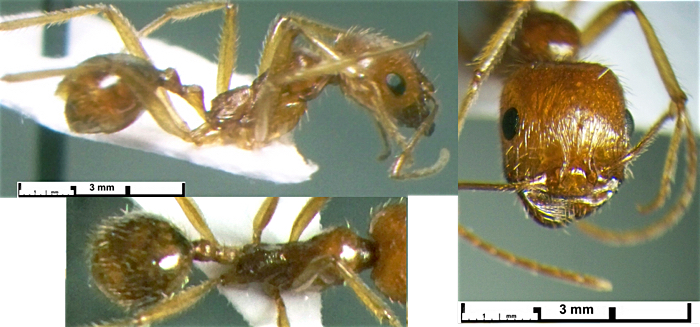 Funiculus
with last four segments elongated; body slender and smooth; colour
yellow, gaster brownish; TL max 7.5 mm Funiculus
with last four segments elongated; body slender and smooth; colour
yellow, gaster brownish; TL max 7.5 mm |
North Africa through Sinai to Syria - rufotestaceus |
| -- | 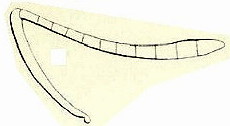 Funiculus
with last four segments not elongated; colour other than yellow Funiculus
with last four segments not elongated; colour other than yellow |
2 |
| 2 | 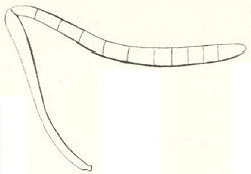 First
segment of funiculus shorter than second First
segment of funiculus shorter than second |
3 |
| -- | First segment of funiculus at least as long as second | 4 |
| . | First segment of funiculus shorter than second | . |
| 3 | 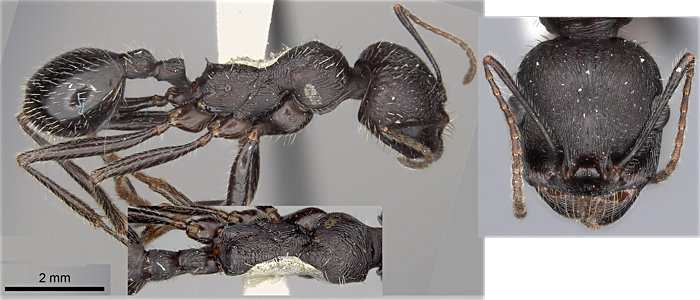 TL
7-16 mm; declivity of mesonotum obviously convex and declivity of
propodeum abrupt (105-110°); propodeum with distinct teeth TL
7-16 mm; declivity of mesonotum obviously convex and declivity of
propodeum abrupt (105-110°); propodeum with distinct teeth |
Across North Africa into Syria - arenarius |
| -- | 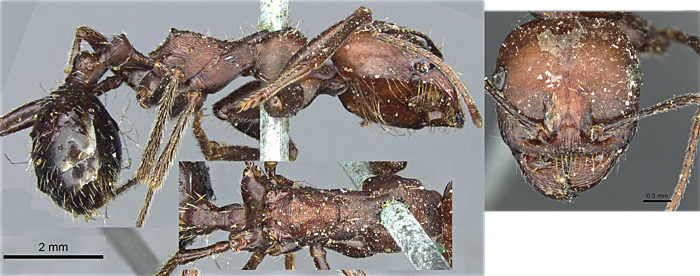 TL
12-16 mm; posterior declivity of mesonotum less convex and of propodeum
less abrupt (120-130°); propodeum with teeth reduced to denticles;
petiole with lower profile than most other species; head, alitrunk and
pedicel matt, densely reticulo-punctate; sides of head longitudinally
striate, plus a detached pair between the frontal carinae running
towards the vertex; generally red, edges of clypeus and frontal carinae,
scape, sometimes lower alitrunk, part of gaster blackish-brown to black,
appendages lighter (media shown) TL
12-16 mm; posterior declivity of mesonotum less convex and of propodeum
less abrupt (120-130°); propodeum with teeth reduced to denticles;
petiole with lower profile than most other species; head, alitrunk and
pedicel matt, densely reticulo-punctate; sides of head longitudinally
striate, plus a detached pair between the frontal carinae running
towards the vertex; generally red, edges of clypeus and frontal carinae,
scape, sometimes lower alitrunk, part of gaster blackish-brown to black,
appendages lighter (media shown) |
Egypt - niloticus |
| . | First segment of funiculus at least as long as second | . |
| 4 |  Occiput with more or less visible transverse striations, alitrunk deeply
striated; petiole profile a low triangle; gaster smooth and shiny; TL 6
mm Occiput with more or less visible transverse striations, alitrunk deeply
striated; petiole profile a low triangle; gaster smooth and shiny; TL 6
mm |
rugosus |
| -- | Occiput with no or only longitudinal striations | 5 |
| 5 | 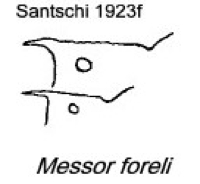 Propodeum
with teeth or spines Propodeum
with teeth or spines |
6 |
| -- | 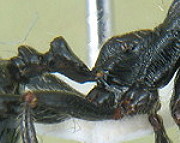 Propodeum
unarmed or with minute denticles/spines (when generally red in colour) Propodeum
unarmed or with minute denticles/spines (when generally red in colour) |
9 |
| . | Propodeum with at least pronounced tubercles | . |
| 6 | 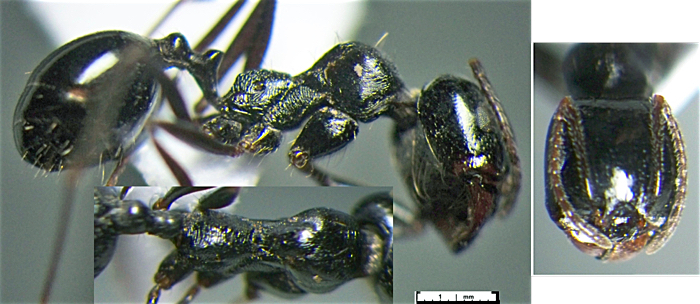 Propodeum
with large teeth (not spines), quite strong but obtuse; body form
slender; head and gaster brilliantly shiny; generally ebony black but
alitrunk may be very slightly reddish in minor workers, tibiae &
tarsi yellowish; alitrunk quite deeply rugose; opaque; TL 4.1-10 mm -
NOTE - the foregoing based on Forel's description, later authors appear
to have the teeth reduced to tubercles; the specimen shown has broad
propodeal teeth Propodeum
with large teeth (not spines), quite strong but obtuse; body form
slender; head and gaster brilliantly shiny; generally ebony black but
alitrunk may be very slightly reddish in minor workers, tibiae &
tarsi yellowish; alitrunk quite deeply rugose; opaque; TL 4.1-10 mm -
NOTE - the foregoing based on Forel's description, later authors appear
to have the teeth reduced to tubercles; the specimen shown has broad
propodeal teeth |
(semirufus ebeninus) Egypt to Syria - ebeninus |
| -- | Propodeum with distinct spines | 7 |
| 7 | 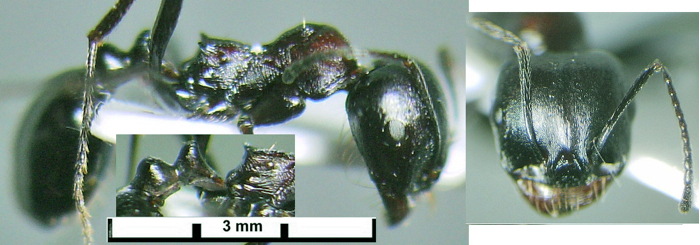 At
least the alitrunk reddish; gaster black; pronotum densely granular,
petiole finely rugose, gaster weakly granular basally, slightly shiny;
propodeum with raised spines, sometimes arcuate; small TL max 6 mm At
least the alitrunk reddish; gaster black; pronotum densely granular,
petiole finely rugose, gaster weakly granular basally, slightly shiny;
propodeum with raised spines, sometimes arcuate; small TL max 6 mm |
Algeria east to Egypt - aegyptiacus |
| -- | Wholly black | 8 |
| 8 | 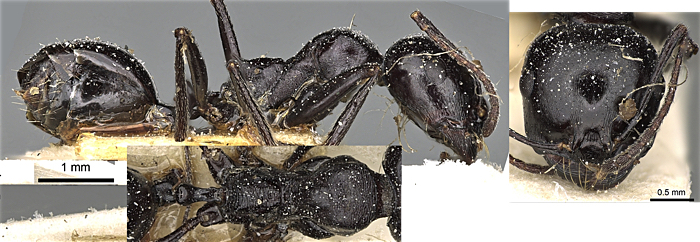 Propodeum
with flat spines, ends downturned; occipitum shiny, with sparse small
rounded fossettes Propodeum
with flat spines, ends downturned; occipitum shiny, with sparse small
rounded fossettes |
(aegyptiacus foreli) Algeria, Tunisia and Sinai - foreli |
| -- |  Head
with longitudinal striations reaching the occiput; longer propodeal
spines with a narrower base than type aegyptiacus Head
with longitudinal striations reaching the occiput; longer propodeal
spines with a narrower base than type aegyptiacus |
Egypt only - aegyptiacus felah |
| -- | Head black, alitrunk usually reddish with superficial rugosity, sometimes lightly shiny; appendages reddish to rust [Santschi, 1927c: 240], reported from Alexandria with reservations by Finzi (1936) - aralocaspius (Ruzsky, 1902c: 20, worker) occurs only in east-central Asia and minor (André, 1883b: 355, worker & queen) from North-east Africa, other than the type form from Italy, type location from Corsica (André, 1883b: 355, worker & queen) - rather small, TL maximum 7.0 mm | [questionable
diagnosis, possibly a one-off immigrant minor from Italy] -
Egypt (Alexandria), Turkestan - minor aralocaspius tamerlani BUT see aegyptiacus |
| -- | Description imprecise (Finzi, 1936: 158); head flatter, longer psammophore; eyes larger, length = the distance eyes forward of occiput; much longer propodeal spines than type aegypticaus; head reddish, alitrunk dark brown (Forel, 1913d, as race of aegyptiacus); TL 4-12 mm | Egypt - aegyptiacus sahlbergi |
| -- | 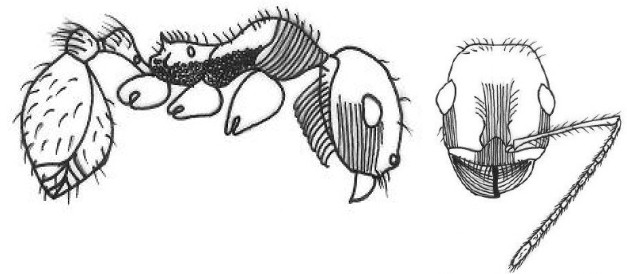 Unicolorous
black; TL 8.8 (minor worker ?); head with dense granulate sculpturation Unicolorous
black; TL 8.8 (minor worker ?); head with dense granulate sculpturation |
Egypt - eglalae |
| Propodeum unarmed or with minute spines/denticles | . | |
| 9 | 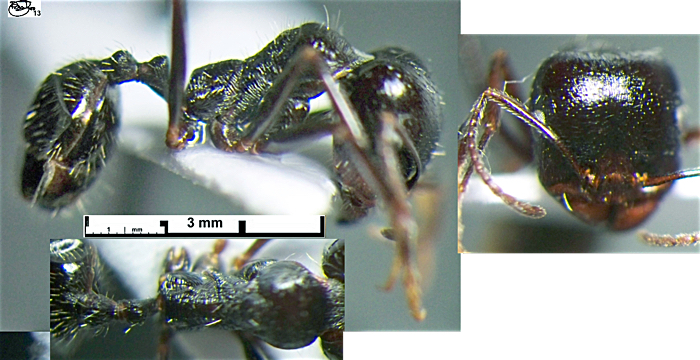 Whole
of body covered with dense pilosity; head and alitrunk strongly striate,
matt; propodeum unarmed; varies from yellow brown to brown black, with
appendages all reddish; TL 3.5-10 mm Whole
of body covered with dense pilosity; head and alitrunk strongly striate,
matt; propodeum unarmed; varies from yellow brown to brown black, with
appendages all reddish; TL 3.5-10 mm |
France east to Central Asia - structor |
| -- | Pilosity sparse to none | 10 |
| 10 | 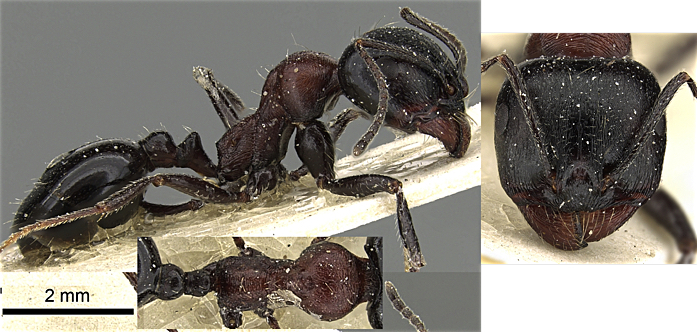 Tl
3-6 mm; head of major relatively small; type form with brown head (queen
black); alitrunk finely sculptured; basal segment of gaster glabrous,
smooth and shiny; scape reaches occiput; clearly higher petiole node Tl
3-6 mm; head of major relatively small; type form with brown head (queen
black); alitrunk finely sculptured; basal segment of gaster glabrous,
smooth and shiny; scape reaches occiput; clearly higher petiole node |
Tunisia, Algeria & "Arabian Desert near Cairo" - medioruber |
| -- | 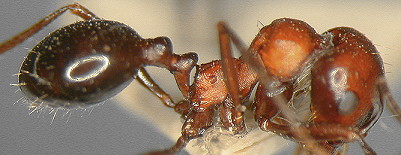 subspecies
generally red; propodeum seemingly with angular tubercles or minute
spines rather than edentate subspecies
generally red; propodeum seemingly with angular tubercles or minute
spines rather than edentate |
medioruber ssp maurus |
| -- | Petiole only moderately high | 11 |
| 11 |  Propodeum
with obtuse transition from dorsum to declivity; apparently overall
darker than type barbarus and head not lighter/more red than
rest; Propodeum
with obtuse transition from dorsum to declivity; apparently overall
darker than type barbarus and head not lighter/more red than
rest; |
Syria, Crete & Sinai (?) - concolor |
| -- | Propodeum with acute transition from dorsum to declivity | 12 |
| 12 | 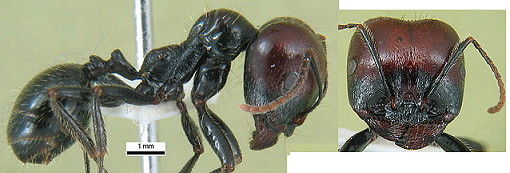 Type
head particularly occiput smooth or near smooth and shiny, alitrunk
quite heavily sculptured; propodeum often unarmed; TL 4-12 mm Type
head particularly occiput smooth or near smooth and shiny, alitrunk
quite heavily sculptured; propodeum often unarmed; TL 4-12 mm |
southern Europe and circum-Mediterranean - barbarus sensu lato |
| -- | 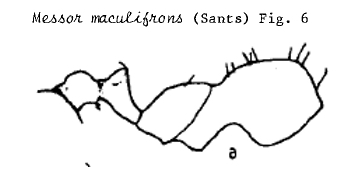 Overall brown-red or brownish-red; head reddish,
patches on head and mesonotum, also parts of legs and gaster more brown,
antennae and rest of legs clear brownish red; propodeum with subvertical
declivity and distinct metanotal groove; TL 5-10 mm; Overall brown-red or brownish-red; head reddish,
patches on head and mesonotum, also parts of legs and gaster more brown,
antennae and rest of legs clear brownish red; propodeum with subvertical
declivity and distinct metanotal groove; TL 5-10 mm; |
(semirufus maculifrons) Egypt, Syria into Caucasus - maculifrons |
| -- |  Overall
smooth or near smooth and shiny, alitrunk weakly sculptured; propodeum
often unarmed; TL 4-8.5 mm; unicolourous red-brown Overall
smooth or near smooth and shiny, alitrunk weakly sculptured; propodeum
often unarmed; TL 4-8.5 mm; unicolourous red-brown |
Egypt & Tunisia - binodis |
| ©2005,
2006, 2008, 2009, 2010, 2015, 2019 - Brian Taylor CBiol FRSB FRES 11, Grazingfield, Wilford, Nottingham, NG11 7FN, U.K. |
href="messor.htm"